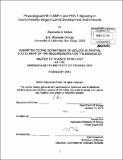| dc.contributor.advisor | Dennis Kim. | en_US |
| dc.contributor.author | Kinkel, Stephanie A | en_US |
| dc.contributor.other | Massachusetts Institute of Technology. Dept. of Biology. | en_US |
| dc.date.accessioned | 2012-04-26T18:49:32Z | |
| dc.date.available | 2012-04-26T18:49:32Z | |
| dc.date.copyright | 2012 | en_US |
| dc.date.issued | 2012 | en_US |
| dc.identifier.uri | http://hdl.handle.net/1721.1/70395 | |
| dc.description | Thesis (S.M.)--Massachusetts Institute of Technology, Dept. of Biology, 2012. | en_US |
| dc.description | Cataloged from PDF version of thesis. | en_US |
| dc.description | Includes bibliographical references (p. 27-29). | en_US |
| dc.description.abstract | The endoplasmic reticulum (ER) is responsible for the folding and processing of approximately one third of proteins in eukaryotic cells, and homeostasis in this compartment is tightly regulated. The Unfolded Protein Response, or UPR, is activated in response to perturbations in protein folding in the ER, collectively termed ER stress. This compensatory mechanism, mediated by IRE-1, PERK- 1/PEK-1 and ATF-6 in metazoans, resolves an overcrowded ER lumen in part through the increase of protein degradation and folding. Typical studies focus on activation of the UPR in response to characterized chemical agents that potently alter ER function or protein stability and folding, leaving physiological or native roles for the UPR relatively uncharacterized. Richardson et al previously demonstrated a role for the UPR in innate immunity in C elegans. Here, in an effort to understand this role, we demonstrate that intestinal expression of XBP-1 is sufficient to overcome PMK-1 dependent larval lethality on a lawn of pathogenic Pseudomonas aeruginosa. Further, we demonstrate that XBP-1 deficiency results in constitutive ER stress even in the absence of pathogenic infection. This elevated ER stress is reflected by increased activities of both IRE- 1 and PEK-1 under physiological conditions. Our data suggest that negative feedback loops involving the activation of IRE-1-XBP-1 and PEK-1 pathways serve essential roles not only at the extremes of ER stress but also in the maintenance of ER homeostasis under physiological conditions. | en_US |
| dc.description.statementofresponsibility | by Stephanie A. Kinkel. | en_US |
| dc.format.extent | 29 p. | en_US |
| dc.language.iso | eng | en_US |
| dc.publisher | Massachusetts Institute of Technology | en_US |
| dc.rights | M.I.T. theses are protected by
copyright. They may be viewed from this source for any purpose, but
reproduction or distribution in any format is prohibited without written
permission. See provided URL for inquiries about permission. | en_US |
| dc.rights.uri | http://dspace.mit.edu/handle/1721.1/7582 | en_US |
| dc.subject | Biology. | en_US |
| dc.title | Physiological IRE-1-XBP-1 and PEK-1 signaling in Caenorhabditis elegans larval development and immunity | en_US |
| dc.type | Thesis | en_US |
| dc.description.degree | S.M. | en_US |
| dc.contributor.department | Massachusetts Institute of Technology. Department of Biology | |
| dc.identifier.oclc | 783829457 | en_US |
